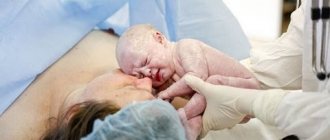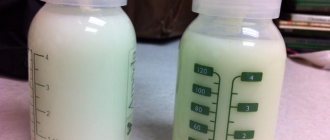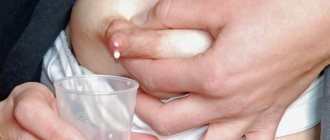The benefits of breast milk for babies are undeniable. Experts still cannot replicate its unique composition to create the “ideal” mixture. That is why pediatricians strongly recommend that mothers do not stop lactation until the baby is 9–12 months old.
But how to organize the process if the girl did not give birth herself, but by caesarean section? The recommendations are quite simple: feeding the baby on demand, pumping, proper nutrition, proper sleep and rest.
How many days have you had no breast milk?
5-6 daysmore than 7 days
The female body is designed in such a way that even after a caesarean section, colostrum and further milk will be produced on its own; this does not require any special effort. The hormone prolactin will begin its work on days 4–7.
But there are still mistakes that can interfere with normalizing lactation both during spontaneous childbirth and during caesarean section. Let's look at them in more detail in this article.
Characteristics of lactation after cesarean section
Most women are sure that breastfeeding is generally impossible after a CS. Obstetricians and gynecologists, in turn, dispute this opinion.
Let's look at how the whole process works. During the operation, a woman’s body experiences enormous stress. Of course, this affects lactation. The special hormone prolactin is responsible for the amount of milk. A woman needs to do everything that he has worked out as much as possible.
How does the process of milk production develop after a CS? The entire period can be divided into several stages:
- Colostrum release. Many people think that there is nothing useful in it. But that's not true. A few drops of colostrum are enough for a newborn to get enough. The liquid is rich in vitamins and minerals. Protects the baby from infections and improves immunity.
- Transitional milk. Released on days 3–6. It has a bluish tint, almost transparent.
- Full lactation process (7–9 days). By this time, the milk is already quite fatty and light yellow in color.
To improve the lactation process, you need to feed your baby often. Forget about feeding by the hour, this practice has long been unwelcome in medicine.
Why there may be no breast milk after a cesarean section
After surgery, the patient should recover. Therefore, nature itself has thought through everything for us. The breasts begin to fill out on days 4–9. But no one has canceled force majeure, which in this case can arise in the functioning of the body of a woman who has given birth. There is no need to panic, even if the deadlines have moved a little. Remember, at this time, more than ever, a calm, balanced state of the mother is important.
No milk after giving birth via cesarean section? Supposed reasons are as follows:
- Doctors' mistake. Perhaps the newborn was immediately taken to the children's ward, without allowing the mother to feed him. There is still debate between experts on this topic. Even 20–30 years ago there was no talk of putting the baby on the mother’s side immediately after surgery. The child was taken to the children's department and shown to his mother only a day later. Modern medicine does not stand still, and accordingly, the method of establishing lactation has long changed.
- The only serious reason why the baby is not immediately applied to the breast of a mother who has undergone a cesarean section may be complications that arise during the operation. In some cases, doctors have to administer drugs that are simply contraindicated in newborns, such as antibiotics. If this happens, then you will have to forget about breastfeeding.
- Scheduled surgery. If a woman’s delivery began naturally, it will be much easier to establish lactation. Indeed, during the initial process (contractions), oxytocin actively enters the blood, which stimulates the formation of prolactin. During planned surgery there is no talk of contractions. Doctors prefer not to wait for them, so as not to harm the little one’s health. This is why the body needs to “get used to” motherhood.
On a note! What to do if after a CS the milk still doesn’t come in? It is important not to despair, to let the baby nurse frequently. Experts also strongly recommend that mothers adjust their diet, create the right menu, get more rest, and do not bottle-feed the baby (a spoon is suitable for these purposes).
Always, if milk does not come, consultation with a specialist is necessary. There is no need to hush up the problem.
Immediately after birth, an experienced nurse working in the maternity hospital comes to the rescue. In many cases, breast massage is recommended. It is better to do it manually; if this is not possible, use a breast pump.
What to do if there is no milk after cesarean section
As noted above, one of the reasons for delayed milk production is a delay in the timing of the first breastfeeding, which may be due not only to the condition of the mother, but also to the condition of the child. His sucking activity may be reduced, so he will not be able to fully suckle at the breast right away. Here, if there are no other contraindications, it is important to be patient and persistent and periodically repeat attempts at breastfeeding. You shouldn’t be too zealous and forcefully breastfeed either. Over time, everything will get better, and the baby will definitely begin to show signs of readiness for feeding (search reflex, smacking). In order for milk to appear faster, the frequency of application is also important. There should be no pacifiers or bottles with nipples.
If it happens that the mother is in intensive care, this does not prevent her from being in the same room with the child, even if we are talking about an intensive care room. According to the International Convention, a woman has the right to ask staff to bring her a child. The exception is the need for the baby to remain under an artificial respiration apparatus.
If, however, it was not possible to reach an agreement, the mother should make every effort to preserve the milk. To do this, you definitely need to pump. As a rule, milk is produced on the 3rd day after birth, and after cesarean on 5-10 days. Mom needs to start pumping from the third day. This needs to be done every 2 hours. The duration of the procedure is 5-10 minutes. Even if milk is produced sparingly, or there seems to be no milk at all, this does not mean that pumping should be stopped. What is important here is not the amount of milk, but the development of the mammary glands in order to form receptors for prolactin. In the future, when you are together, offer your baby the breast as often as possible.
Inappropriate attachment of the baby to the breast can also affect the flow of milk. If the baby does not grasp the nipple and areola correctly, then he does not stimulate the breast well and will not empty it completely enough, and this will not bring positive emotions to the mother. Such actions lead to cracked nipples and each subsequent feeding will seem like hell due to unbearable pain. This is why it is so important to ensure that the baby grasps not only the nipple, but also the areola.
Frequent application at night will allow you to establish lactation. The mother's nutrition is also very important. To increase milk volume, you should adhere to a diet - eat more vegetables, cereals, lean meat, and nuts. A nursing mother needs to drink about a liter of warm tea with milk a day.
When does milk come in after a caesarean section?
Patients who gave birth without surgical assistance can begin breastfeeding immediately. The breasts become fuller already on the 1st or 2nd day. The process is quite simple. Already at the stage of delivery, oxytocin and prolactin enter the woman’s blood. These hormones are responsible for milk production.
During a planned caesarean section the situation is different. Natural contractions do not begin. Doctors only inject the woman with a small amount of oxytocin so that the uterus begins to contract and returns to its natural state.
Alas, this amount is not enough for full lactation to begin. In this situation, it takes time for the brain centers to receive the signal from the mammary glands, and the process starts.
On what day does milk come in after a CS? As a rule, on days 4–9. This time is just enough for the woman to recover a little after the operation. The woman in labor has already been transferred from intensive care to the general ward. This is where being together with the baby begins.
It is important! No specialist can say with certainty when milk comes in after a cesarean section. This process is quite individual. It largely depends on the general condition of the woman.
There are many ways to increase and stimulate lactation:
- Place your baby on your breast frequently. During this period, doctors even recommend co-sleeping so that the mother can offer feeding to the little one at any time.
- Maintain water balance. Ideal mother's helpers: rose hips, green tea, raisin decoction.
- Use a breast pump.
- Don't forget to pump.
- Introduce the right foods into your diet.
- Get enough sleep.
- Be less nervous.
Advice! Has colostrum appeared? Great! The lactation process has started, and the mother’s task is not to be lazy and feed the baby often. It is the newborn who is the best assistant in the process of milk production.
What to do if milk does not come after cesarean?
All women receive milk after childbirth. It does not matter whether the child was born naturally or through surgery. Milk comes at different times and in different quantities. Some women pour the excess after pumping into the sink, while others save the nutrition to the last drop, just enough to satisfy their baby.
If too little milk comes in, it is necessary to increase lactation. This can be done with proper nutrition. Every day a woman should eat nuts, beef and wheat porridge. Also drink a lot of warm liquid, preferably warm tea with condensed milk or milk. Put the baby to the breast as often as possible, especially at night, when breast milk is being produced.
Even if the baby is sleeping, he must be woken up and attached to the breast. By sucking, he provokes the flow of milk in large quantities, and thanks to proper nutrition, it will be even fatter and more nutritious. All these actions will help produce the hormone prolactin, which is primarily responsible for the flow of milk in the required quantity for breastfeeding a newborn.
Useful links:
Restoration of lactation after surgery
There is nothing difficult about establishing lactation after a caesarean section. The following rules must be followed:
- Place your baby on the breast as quickly as possible after surgery. You should not be afraid of the harm of drugs and anesthesia that entered the bloodstream during the CS.
- When milk comes in after a caesarean section, you need to feed the baby at least once every 1.5 hours. What if he is sleeping? Definitely - to wake up. Don't be lazy to do this.
- If your newborn is not breastfeeding well, do not forget to express milk. In this way, you will not only avoid lactostasis, but also increase the amount of liquid received.
- Remember the need and benefits of proper nutrition. The diet should contain fruits and vegetables that are allowed to the mother during breastfeeding.
- Stay hydrated.
Advice! It is very important to learn how to properly apply the baby to the mother’s breast. It should capture the nipple as much as possible, without affecting the areola. If this is the first time a mother has encountered this process, it is better to consult a specialist.
How to develop breasts?
If you do nothing, there is a chance that the milk will never come. What to do for those who do not have milk after a cesarean section should be advised by a doctor.
This is how lactation is usually accelerated. A woman should begin pumping for five minutes every 2 hours as soon as possible after she has recovered from the procedure.
Of course, a caesarean section is a very, very difficult operation, and supermams.ru perfectly understands your condition after it, but if you want to breastfeed your baby, then breast development is necessary.
It’s still not worth waiting for the milk to flow and then you will put the baby to the breast. Already while in a standard ward after resuscitation, a young mother should teach her child to suck the breast. This is how he gains this skill, plus the process of producing oxytocin starts in your body. It is this substance that is responsible for the secretion of milk. Yes, drop by drop first.
Doctors' opinion
All obstetricians and gynecologists agree: after a CS, a woman can and should breastfeed. Why don't many people succeed in this? The main reason lies in the mother's insufficient knowledge regarding breastfeeding.
What advice can you give:
- Not enough milk? First of all, consult a specialist. It may be enough to develop the breasts to open the ducts.
- Is it possible to supplement the baby? Of course, but you need to do this with a spoon so that he doesn’t get used to the bottle.
- If there is no milk at all, what should I do? In this case, you will need the help of a mammologist and, possibly, a number of additional examinations (ultrasound, tests).
It is important! CS is a difficult operation. A woman’s physical and emotional state does not always return to normal quickly. Even these factors can influence the fact that a woman in labor has little milk. This is why the care and support of loved ones is so important during this period.











